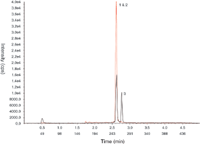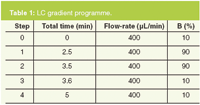Analysing Testosterone in Human Serum by UHPLC Using High Efficiency Kinetex 1.7 µm C18 Core-Shell Columns
Phenomenex Application Note
Testosterone was extracted from human serum by strong anion exchange polymeric SPE and analysed using a Kinetex C18, 30 × 2.1 mm, 1.7 μm column and positive polarity ESI LC–MS–MS system. Kinetex sub-2 μm core-shell technology offers higher efficiencies than traditional sub-2 μm columns, producing greater chromatographic resolution, sensitivity and higher peak capacities.
Introduction
Testosterone is an androgenic steroid responsible for the development of male reproductive organs, maintaining (or increasing) muscle mass and bone density. As anabolic steroids, testosterone has been used (or abused) to increase muscle mass and enhance the athletic performance. The concentration of testosterone is lower in female population than men and in general diminishes with advancing age. Monitoring body concentration of testosterone is an aid in diagnosing and treating disease state related to the hormonal imbalance.

Figure 1: The separation of 100 pg/mL standard of testosterone and epitestosterone extracted from human serum on Kinetex C18, 30 Ã 2.1 mm, 1.7 um using the LC gradient profile listed in Table 1. Testosterone retention time is 2.62 min, Epitestosterone 2.77 min and Int. Std is 2.61 min.
The analysis is based on a simple extraction method using strong anion exchange SPE (Strata-X-A) to produce a clean extract from human serum. Following the extraction, testosterone is derivatized to form an oxime which is then analysed in positive mode ESI LC–MS–MS under multiple-reactions-monitoring function (1). A short-length 30 mm, 1.7 um Kinetex C18 column efficiently separates testosterone from its isomeric form epitestosterone (Figure 1).
Experimental Conditions
The mobile phase consisted of 0.1% formic acid with 1 mM ammonium formate with no pH adjustment, in water (MP A) and acetonitrile (MP B). A typical LC gradient is used (Table 1) for the separation.

Table 1: LC gradient programme.
An AB Sciex API 5000 triple-quadrupole tandem mass spectrometer is used for analysis equipped with an ESI probe operating in positive polarity mode. Under an MRM mode, two channels were monitored for Testosterone and Testosterone-D3 (Table 2).

Table 2: MRM transitions used for data analysis.
Results and Discussions
As is demonstrated from the chromatogram, the Kinetex column provides a high degree of selectivity even in small dimensions to provide superior chromatographic separation. For further details or questions contact your Phenomenex sales representative.
References
1. M.M. Kushnir et al., Clinical Chemistry, 52(1), 120–128 (2006).

Phenomenex Inc.
411 Madrid Ave., Torrance, California, USA
tel: +1 310 212 0555 fax: +1 310 212 7768
Website: www.phenomenex.com

Silvia Radenkovic on Building Connections in the Scientific Community
April 11th 2025In the second part of our conversation with Silvia Radenkovic, she shares insights into her involvement in scientific organizations and offers advice for young scientists looking to engage more in scientific organizations.
Regulatory Deadlines and Supply Chain Challenges Take Center Stage in Nitrosamine Discussion
April 10th 2025During an LCGC International peer exchange, Aloka Srinivasan, Mayank Bhanti, and Amber Burch discussed the regulatory deadlines and supply chain challenges that come with nitrosamine analysis.
Removing Double-Stranded RNA Impurities Using Chromatography
April 8th 2025Researchers from Agency for Science, Technology and Research in Singapore recently published a review article exploring how chromatography can be used to remove double-stranded RNA impurities during mRNA therapeutics production.


















